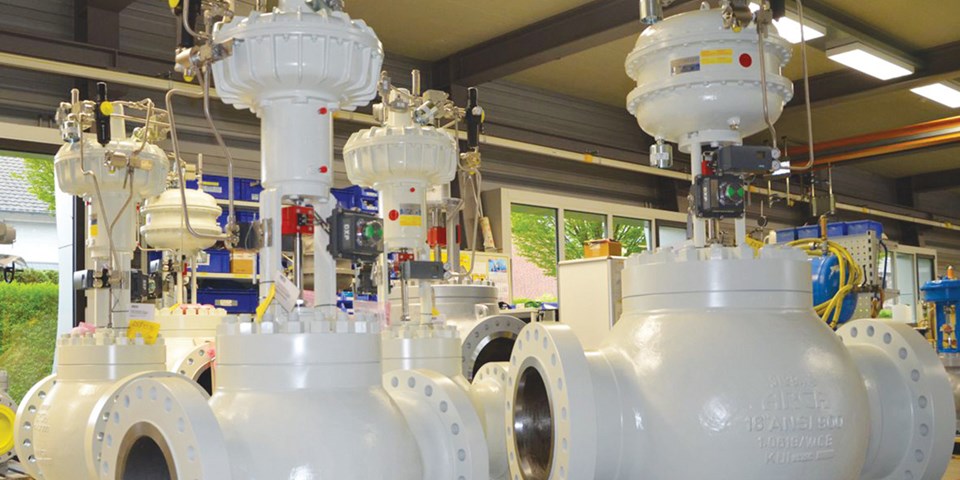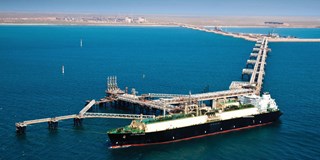^ Anti-surge control valves from Arca Regler
Article By Bob McIlvaine
___
The oil and gas industry is one of the largest and most dynamic segments of the valve market. Who would have predicted in 2000 that the U.S. would be the largest combined producer of oil and gas? It happened because of a process development “hydraulic fracturing”.
The result is not only a geographical shift in the valve market but the need for new valve designs to deal with abrasive combinations of chemicals and sand injected at high pressures. These changes in the processes and valve designs need to be assessed in determining a market strategy. The market share pyramid is a structure which adds clarity to the analysis and resultant decision making.
The valve revenue forecast in a niche is a function of a market share pyramid. Therefore a ‘holistic market share analysis’ is vital.
It all starts with oil and gas demand. This is a function of GDP and alternative fuel options such as electric cars, and it results in a secondtier on the pyramid representing the industry investment.
This investment needs to be further segmented as to whether it is an investment for new production or to maintain existing production. Valve purchases for new production are cyclic, whereas valve purchases for maintaining production are relatively stable. Hydraulic fracturing is having the effect of creating smaller undulations in the production investment. Since the investment in a new well is modest and can quickly be producing, it is now easier to match supply and demand.
Sinopec
The size of the investment in each geographical market is essential. However, since purchasing is becoming more centralized, it is equally important to determine worldwide investments by Shell, Chevron, Exxon Mobil and the other major participants. This analysis can be further refined to provide competitor market shares for each. In the case of Sinopec, the company is both the largest valve purchaser (taking into account its various activities) and also a competitor. It is an operator but also a supplier of mobile hydraulic fracturing units completely fitted with valves.
The geographical investment is made more confusing by the multiple geography impacts for certain products such as LNG. It is liquefied in one country, transported to another country and then regasified in another. The initial valve deliveries for the transport segment are likely to be to a shipyard in Asia.
Various processes
Staying with the LNG-case, there are new applications and changes to existing applications: subsea extraction, gas to liquids, LNG, transport by pipeline or ship have unique valve requirements. There is the interchangeability of sources and applications. If the price or availability of LNG from the Middle East or the U.S. becomes a problem, China will invest more heavily in the gasification and liquefaction of coal. It will use syngas as a substitute for natural gas in commercial and residential heating as well as gas turbine power generation.
It is also essential to distinguish among various processes. There are common processes such as water intake clarification and wastewater treatment which are common to many oil and gas processes. Power is required in many applications. You will find valves on steam lines on an ocean drilling rig and in a gas-to-liquids onshore processing plant. Processes directly involving the product often require unique valves. These products should be able to withstand high temperatures, cryogenic conditions or abrasive or corrosive fluids.
Definitions
The unique conditions require unique valves. It is vital to make the most meaningful segmentation for the valve types which are considered. Choke valves are an example. The choke valve market ranges between $250 million and $400 million per year, depending on the definition and where we are in the oil and gas cycle.(1) A significant portion of choke valve sales is to oil and gas companies. The definition also has a significant effect on revenue determination. The terms choke, control and axial are used in different ways. With some definitions, the market is much larger than with others. Here are some ways the term is defined:
- Flow Path: Angle most important. If it is axial, it is control; if it is angle, it is choke.
- Trim: If one type of trim is used, it is most suitable for choke; if another, it is for control.
- Location: If it is extraction, it is choke; if it is another application, it is control.
- Valve type: For some valve suppliers, “choke” is just one of a number of applications and not a type of valve.
Insights
Anti-surge valves are unique designs and are relatively expensive. There is a limited number of suppliers. They are used with compressors on a number of applications.
Valve companies that pursue the anti-surge valve market need to understand each of these different applications along with the identification of the decision-makers. How important are the compressor or process suppliers in the selection of the individual valve company? Who are the major compressor suppliers? Are the requirements different depending on the compressor design? How do the demands in a refinery application differ from those in a gas pipeline?
Concluding, creating a market share pyramid for each application and each valve type will provide necessary insights into the specific needs in a market segment, driven by various needs and demand. It is also inexpensive, and the rewards are well worth the expense.
(1) Valve World Markets published by the McIlvaine Company





